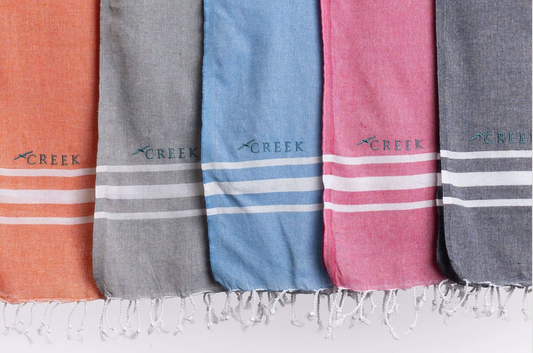The History of the Shipping Forecast: A Maritime Legacy
Every night, over one million people tune into BBC Radio 4 to hear a weather forecast they'll never use. This tradition has lasted over 100 years. It's a beloved part of British culture.
The Met Office makes this weather forecast for 31 sea areas around the British Isles. But it's loved by more than just sailors. It's a soothing bedtime story or indeed wake up call for many the United Kingdom.
At Creek Lifestyle, we love this connection to coastal heritage. Our Shipping Forecast collection celebrates this legacy with beautiful designs. Each piece brings the sea's poetry to life, showing Britain’s deep bond with the ocean and the weather.
This tradition is more than just weather reports. It shows how something practical became a cultural icon. The forecast is woven into British identity, like the sea is to our coastal towns. It connects us to the sea's rhythm, which is at the heart of our nation.
Key Takeaways
- Over one million people listen to the shipping forecast nightly, despite most never sailing
- The maritime weather service has operated for more than 150 years as a British institution
-
BBC Radio 4 broadcasts forecasts for 31 designated sea areas surrounding the British Isles
- The Met Office produces these specialised maritime weather reports for seafarers, marine enthusiasts, fishermen and small coastal boat users
- Creek Lifestyle's collection honours this coastal heritage through contemporary design
- The forecast represents Britain's cultural connection to maritime traditions and coastal living
- This broadcasting ritual demonstrates how practical services can become cherished cultural touchstones
1. The Tragic Storm That Changed Everything: Royal Charter Disaster of 1859
Sailors once faced the sea with hope and prayer, before storm warnings existed. We know the sea's power well, and it demands our respect. The Royal Charter disaster in October 1859 changed maritime safety forever, from loss to innovation.
The Steam Clipper Royal Charter's Fatal Journey
The Royal Charter was a marvel of Victorian engineering. It had sailed from Australia, full of gold and passengers. Its design combined sailing and steam technology.
As it neared the Welsh coast, a storm brewed. The crew, seasoned in ocean travel, couldn't predict the storm's fury off Anglesey's coast.
450 Lives Lost Off the Coast of Anglesey
On that fateful October night, 450 lives were lost. The Royal Charter crashed on Anglesey's rocks, unable to withstand the storm. Families at harbour never saw their loved ones again. Learn more about the Royal Charter shipwreck and how it changed maritime safety forever.
The disaster shocked the nation. It showed even advanced ships were vulnerable to storms.
Vice-Admiral Robert FitzRoy's Call for Action
Vice-Admiral Robert FitzRoy saw the disaster and knew change was needed. He wanted storm warnings to prevent such tragedies. His vision led to modern weather forecasting, giving sailors early warnings of danger.
|
Before Royal Charter Disaster |
After FitzRoy's Innovation |
Modern Impact |
|
No advance storm warnings |
Telegraph storm alerts from 1861 |
Comprehensive shipping forecasts |
|
Ships sailed without weather knowledge |
Systematic meteorological observations |
Satellite weather monitoring |
|
High maritime casualty rates |
Reduced storm-related disasters |
Enhanced maritime safety protocols |
|
Reactive emergency responses |
Proactive warning systems |
Automated alert technologies |
2. The Complete History of the Shipping Forecast: From 1861 to Modern Day
It all began with urgent telegraph messages in 1861. Today, the shipping forecast guides sailors home. This journey shows our deep connection to the sea and our dedication to those who sail it.
First Storm Warnings by Telegraph in 1861
Vice-Admiral Robert FitzRoy changed maritime safety in February 1861. He started the first storm warning service by telegraph. Coastal stations shared vital weather info across Britain's shores.
FitzRoy also coined the term "weather forecast". His service linked ports and harbours with telegraph wires. This saved countless lives by sharing weather knowledge.
The Met Office Takes Control
The meteorological office improved FitzRoy's work in the late 1800s. They developed better ways to gather and share weather data. This laid the groundwork for today's forecasting.
By the early 1900s, the service covered commercial shipping and naval operations. It served our coastal waters well.
BBC Radio 4's First Broadcast on 1st January 1924
The move to radio broadcasting was a big step. On 1st January 1924, "Weather Shipping" began. It was the first maritime weather broadcast on British radio.
This broadcast connected ships in our waters like never before. By October 1925, the BBC took over. They turned it into the shipping forecast we know today.
Development of Sea Areas Around the British Isles
Defining forecast areas brought order to weather reporting. By 1949, 31 sea areas were set up, arranged clockwise around the British Isles.
Each area has its own character and history. Names like Viking in the north and Sole in the southwest are part of our coastal culture.
The Shipping Forecast areas are;
Viking, North Utsire, South Utsire, Forties, Cromarty, Forth, Tyne, Dogger, Fisher, German Bight, Humber, Thames, Dover, Wight, Portland, Plymouth, Biscay, Trafalgar, FitzRoy, Sole, Lundy, Fastnet, Irish Sea, Shannon, Rockall, Malin, Hebrides, Bailey, Fair Isle, Faeroes, and Southeast Iceland
|
Year |
Milestone |
Technology |
Coverage |
|
1861 |
First storm warnings |
Telegraph |
Coastal stations |
|
1924 |
Weather Shipping begins |
Radio broadcast |
British waters |
|
1925 |
BBC takes control |
Radio transmission |
Extended coverage |
|
1949 |
Modern format established |
Advanced radio |
31 sea areas |
3. Beyond Maritime Safety: The Shipping Forecast in British Culture
Every evening, hundreds of thousands of Britons tune in to hear weather reports they'll never need. The Shipping Forecast has become a cherished part of British culture. Read about the calming rhythms of the Shipping Forecast in this heartfelt piece from The Guardian.
The Soothing Rhythm That Sends Britain to Sleep
The measured cadence of the evening broadcast is mesmerising. The rhythmic recitation of wind speeds and visibility reports creates an unexpected lullaby. Many listeners find themselves drifting off to sleep as familiar names roll across the airwaves—Rockall, Hebrides, Irish Sea, German Bight.
The forecast's frequency and consistent format provide comfort in our chaotic world. Its predictable structure offers a sense of stability. This helps ease the transition from day to night.
Inspiration for Musicians and Writers
The poetic quality of the Shipping Forecast has captured creative minds for decades. Musicians from Blur to Radiohead have drawn inspiration from its mysterious place names and rhythmic delivery. The forecast's unique blend of practical information and evocative language creates something approaching poetry.
Writers and poets have long celebrated the broadcast's ability to transport listeners. They are taken beyond their sitting rooms to wild Atlantic Ocean waters and distant shores through words alone.
Symbol of Coastal Living and British Heritage
The forecast represents our island nation's enduring relationship with the sea. It connects us to centuries of maritime tradition. Reminding us that Britain's identity remains intrinsically linked to coastal living and seafaring heritage.
Creek Lifestyle's Celebration of Maritime Tradition
We understand this cultural significance deeply. Our Shipping Forecast collection transforms these beloved maritime references into everyday treasures. Through carefully crafted mugs, tea towels, and textiles, we bring the romance of these legendary sea areas into daily life. We celebrate Britain's unique maritime culture.
A Timeless Maritime Legacy That Continues Today
In our digital age, the Shipping Forecast stands strong. It uses advanced tech and satellite data. Yet, hundreds of thousands tune into BBC Radio each evening for this ritual.
The covid-19 pandemic briefly threatened these broadcasts. But public demand proved stronger than any storm. From BBC World Service to BBC Radio 2, this signal continues its journey across Britain.
During World War II, the forecast gave vital info for naval operations. From the BBC Light Programme to the BBC Home Service, these broadcasts have faced every challenge. They've been on the airwaves ever after the BBC National Programme first aired them.
At Creek Lifestyle, we celebrate this lasting bond between past and present. Our coastal collections honour Britain's maritime heritage. Whether you're listening to the late forecast or starting your day with our Shipping Forecast mugs, you're part of a long tradition.





